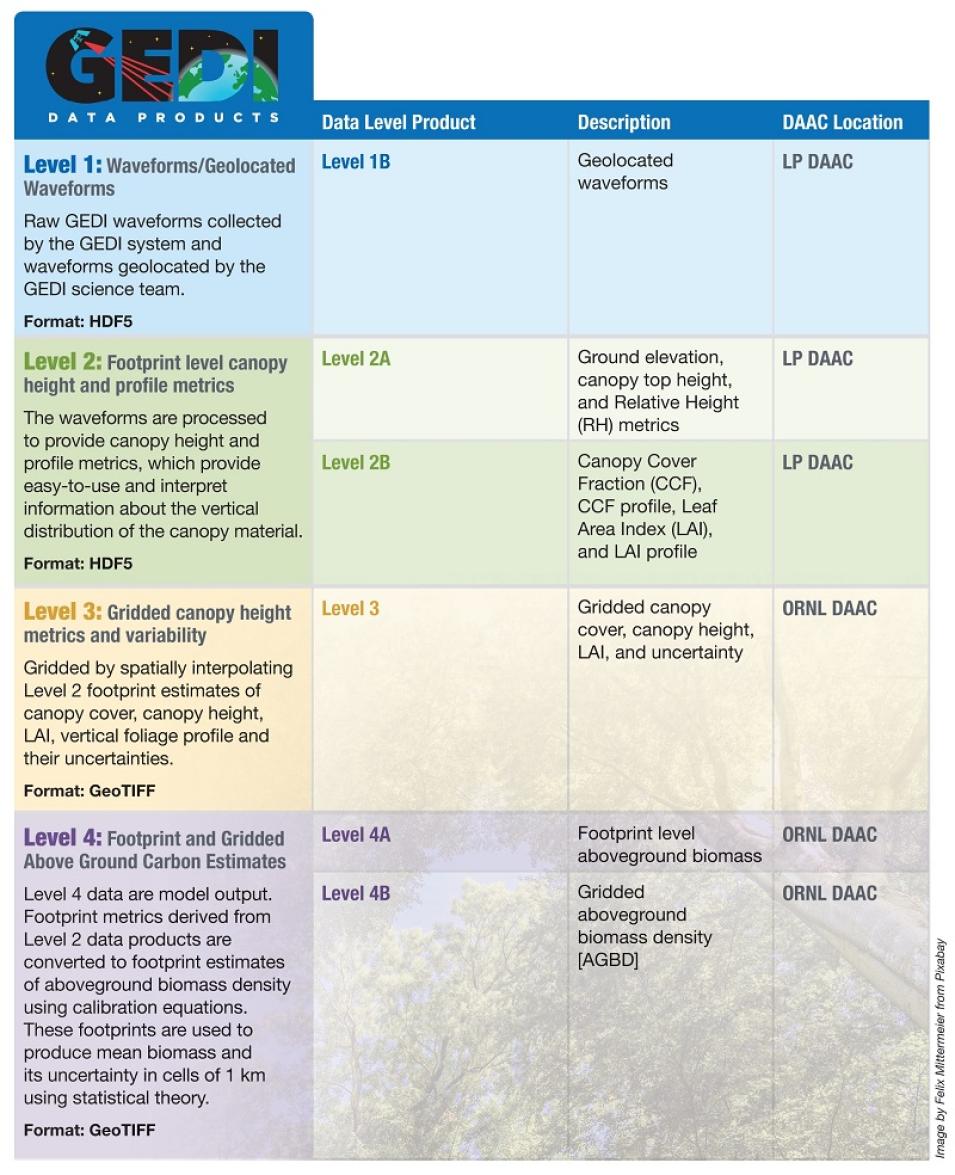The three lasers comprising the GEDI lidar system produce eight parallel observation tracks. Each laser fires 242 times each second and illuminates a 25-meter spot on the surface over which the surface’s 3D structure is measured. Each 25-meter spot is separated by 60 meters along track, with about 600 meters between each of the eight tracks. Approximately 10 billion observations will be produced over the two-year mission.
The sole GEDI observable is the waveform of the returned laser pulse, and all data products are derived from this measurement. Lidar waveforms quantify the vertical distribution of vegetation by recording the amount of laser energy reflected by plant material (stems, branches, and leaves) at different heights above the ground. Signal processing is used to identify the ground within the waveform, and the distribution of laser energy above the ground can be used to determine the height and density of objects within the 25-meter GEDI footprint. Four types of structure information can be extracted from GEDI waveforms: surface topography, canopy height metrics, canopy cover metrics, and vertical structure metrics.
GEDI data will contribute significantly to research studying the development of terrestrial biomes, and will help further refine our understanding of the carbon cycle and atmospheric concentrations of carbon dioxide (CO2). Along with helping provide answers to how deforestation has contributed to atmospheric CO2 concentrations, how much carbon forests will absorb in the future, and how habitat degradation will affect global biodiversity, GEDI data also will help identify and provide a better understanding of how physical disturbances affect ecosystems and carbon storage.
GEDI’s location on the space station means that the instrument does not collect data in a standard data pattern, such as polar-orbiting satellites like NASA’s Terra or Aqua that cross the same point on Earth at the same time every day. “Being on the space station, GEDI has a rather strange, precessing orbit that is not Sun-synchronous, covers about 53 degrees north and south latitude, and is angled across the equator,” explains Maiersperger. “This means it can’t cover the entire Earth and it completes about 12 to 16 orbits per day. If you flatten this orbit out, you end up with these four-kilometer-wide swaths that the GEDI lasers are firing across in these spaghetti-looking patterns.”
The GEDI instrument also can be pointed, which provides further coverage for the GEDI lidar. The ability to rotate the instrument up to six degrees allows the lasers to be pointed as much as 40 km on either side of the space station’s ground track. This feature enables GEDI to sample Earth’s surface as completely as possible given the space station’s orbital track.
Once the GEDI data product generation cadence is set, LP DAAC expects to provide approximately 16 terabytes (TB) of GEDI data per month. “From a data volume standpoint, GEDI is not a big deal for us,” says Cody Hendrix, a systems engineer on the LP DAAC GEDI data team. “Probably the bigger challenge is we’ll have 10 billion individual laser shots [over the two-year mission] that we’ll have to keep track of and try to distribute to users in a cogent way. Because of the space station’s acquisition and orbital characteristics, there’s a lot more education I think we’re going to have to do with the end users to help them understand the very non-standard orbit [of the space station].”
Now that the first GEDI data are available through NASA’s LP DAAC (and soon will be available through NASA’s ORNL DAAC), the global research community is about to embark on an exciting new era of ecosystem studies. “There are a lot of people in a wide range of fields who are just out of their minds excited about getting their hands on GEDI data and using these data,” says Maiersperger. “It will be a very rich dataset.”
Learn more about GEDI and GEDI data
GEDI mission website: https://gedi.umd.edu/
LP DAAC GEDI Landing Pages:
ORNL DAAC GEDI Landing Page (Level 3 data expected in mid-2020; Level 4 data expected in early-2021): https://daac.ornl.gov/gedi

